Secretary of State Rex Tillerson recently laid off a batch of State Department staffers on the seventh floor of Washington’s Harry S. Truman Building.
On Feb. 16, “much of seventh-floor staff,” the people who work for the Deputy Secretary of State for Management and Resources and the Counselor offices, were shown the door, according to a CBS News report.
This is a common move under most new administrations, according to James Carden, a contributing writer at The Nation and a former adviser to the U.S.–Russia Presidential Commission at the U.S. State Department.
The seventh floor consists of deputy secretaries and undersecretaries, nearly all of whom are political appointees.
There has been mixed reporting on Tillerson laying off the seventh-floor staff.





